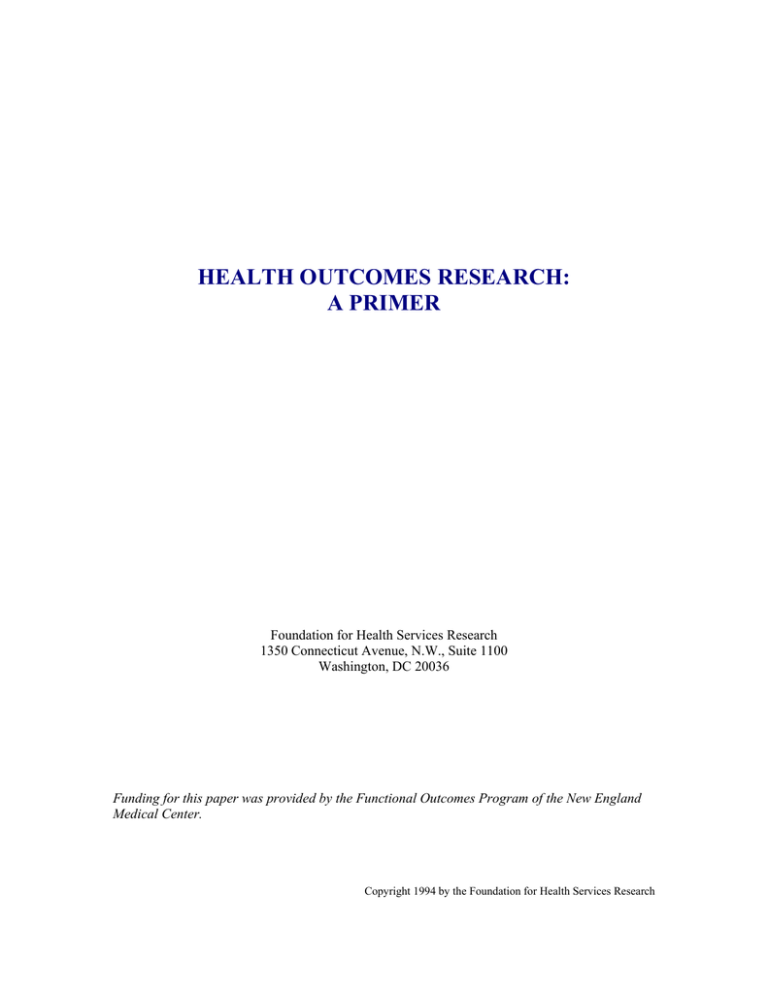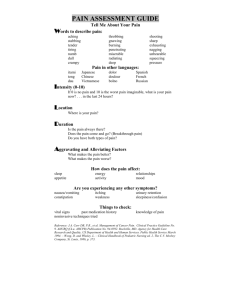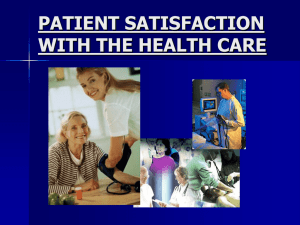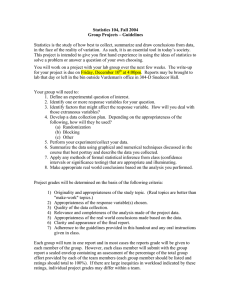HEALTH OUTCOMES RESEARCH: A PRIMER
advertisement

HEALTH OUTCOMES RESEARCH: A PRIMER Foundation for Health Services Research 1350 Connecticut Avenue, N.W., Suite 1100 Washington, DC 20036 Funding for this paper was provided by the Functional Outcomes Program of the New England Medical Center. Copyright 1994 by the Foundation for Health Services Research Introduction Health outcomes research, medical effectiveness appropriateness criteria, and clinical practice guidelines are words and concepts long familiar to the health services research community. They have more recently entered the vocabulary of a wide variety of groups concerned with health care, including members of Congress, health industry officials ranging from the insurance sector to drug and medical device companies, major employers and consumer groups. This paper is designed to explain what these terms mean, why they are important, and how health outcomes research can lead to improvements in the health care system and ultimately to health of Americans. It answers the following questions: • What is outcomes research? • What makes outcomes research different? • • • How does outcomes research provide answers for policymakers, clinicians, managers and payers? How is health status measured? What are the best ways to incorporate the results of health outcomes research into the health care process? • Who funds outcomes research? • Where do we go from here? 1 What is outcomes research? Outcomes research studies the end results of medical care – the effect of the health care process on the health and well-being of patients and populations. It spans a broad spectrum of issues from studies evaluating the effectiveness of a particular medical or surgical procedure to examinations of the impact of insurance status or reimbursement policies on the outcomes of care. It also ranges from the development and use of tools to measure health status to analyses of the best way to disseminate the results of outcomes research to physicians or consumers to encourage behavior change. The field of outcomes research emerged from a growing concern about which medical treatments work best and for whom. In large part because of its potential to address the interrelated issues of cost and quality of health care, public and private sector interest in outcomes research has grown dramatically in the past several years. Funding for the federal government’s flagship program in outcomes research – the Medical Treatment Effectiveness Program (MEDTEP) administered by the Agency for Health Care Policy and Research (AHCPR) grew dramatically between 1989 and 1991 from $6 million to $63 million. Funding has increased more slowly over the past several years, to $73 million in 1993. Insurance companies, employers, state and federal governments and consumers are all looking to outcomes research for information that will help them make better decisions about what kind of medical care is appropriate (and should be reimbursed), for whom, and when. The broad ranging issues encompassed by outcomes research can be viewed as a complex puzzle that together will help improve the operation of the health care system and ultimately the health of Americans What makes outcomes research different? The Question It Asks A hallmark of outcomes research is the breadth of issues it addresses. Outcomes research touches all aspects of health care delivery, from the clinical encounter itself to questions of the organization, financing and regulation of the health care system. Each of these factors plays a role in the outcome of care, or the ultimate health status of the patient. Understanding how they interact requires collaboration among a broad range of health services researchers, such as physicians and nurses, economists, sociologists, political scientists, operations researchers, biostatisticians and epidemiologists. 2 The Setting It Studies Outcomes research evaluates the results of the health care process in the real-life world of the doctor’s office, hospital, health clinic and even the home. This contrasts with traditional randomized controlled studies, funded mainly through the National Institutes of Health, which test the success of treatments in controlled environments. These are called efficacy studies. Research in real-life settings is called effectiveness research. The Health Status Measures It Uses Traditionally, studies have measured health status, or health outcomes, in terms of physiological measurements – through laboratory test results, complication rates (e.g. infections) or death. These measures alone do not adequately capture health status. A patient’s functional status, well-being, and satisfaction with care must compliment the traditional measures. The Methods It Uses Constraints of money and the time it takes to conduct large, long term clinical trials is a major challenge of outcomes research. One strategy of overcoming this barrier is to use existing computerized databases, such as those available from Medicare, Medicaid, private insurance companies, and major employers. Another strategy is to use simple questionnaires that patients can use to evaluate their own health and health care. Outcomes research also uses meta-analysis, a technique to summarize comparable findings from multiple studies. These approaches complement the more standard research strategies involving the collection and analysis of information from medical records and other clinical and management data. How can outcomes research provide answers for policy makers, clinicians, managers and players? The field of outcomes research combines several types of research that together are providing better information to doctors and patients. This contributes to more informed decision making which will help improve the value for the health care dollar. These include studies of the variations in medical practice patterns, effectiveness research that assesses which treatments for specific clinical problems work best for whom, appropriateness studies that determine the circumstances in which a procedure should and should not be performed, research that develops tools to identify patient preferences when treatment options are available, and research that creates methods to measure changes in health status and patient satisfaction with the health care process. 3 By Identifying Variations in Medical Care Over the past two decades, studies have reported that residents of New Haven are twice as likely to undergo coronary artery bypass surgery as residents of Boston. Eight percent of the children in one Vermont community have tonsillectomies compared to nearly 70 percent in another community. Women living in the southern region of the United States have a 1.5 times greater rate of hysterectomies than women living in the northeast and the general rate of gastro-intestinal endoscopy is two times higher in the west than the northeast. Health services researchers have been unable to explain these wide variations in physician practice patterns by patient characteristics or by the medical resources in a community. Although many examples such as these have been found, it was only recently that outcomes researchers took the next step and asked, “which practice styles are best?” They are exploring whether the practice variations are signs of too much care, too little care or both. And they are exploring the circumstances under which patients benefit from a procedure and when they do not. By Comparing the Effectiveness of Various Treatments and Procedures The effectiveness of procedures or treatments depends on a variety of clinical and nonclinical factors. Clearly, whether the treatment itself works is the starting point. But many other factors can affect the success of a treatment, including: • Training and experience of the provider: Does the outcome differ if the provider is a physician (specialist or generalist) or a nurse practitioner? Does the outcome differ if physicians have more or less experience doing a particular procedure? • Communication among the caregiving team: Do outcomes differ as a function of the ability of the caregivers to work together? • Financial incentives affecting the patient and provider: Does insurance coverage or the way a physician is paid (salary or fee-for-service) affect the outcome of care? • Socio-economic status of the patient: Does poverty or ethnic background affect the way patients seek care or are treated once they are in health care system? • Setting in which the care was provided: Do outcomes differ if care is provided in a hospital emergency room, health maintenance organization (like Kaiser Permanente) or a private doctor’s office? 4 What is most beneficial to one patient may not be for another. The challenge to the health services researcher is to provide the information that will help match specific treatments to individual patients. By Developing Appropriateness Criteria Even though a procedure has proven to be effective, it is not appropriate for every patient in all circumstances. For example, a study of Medicare patients showed that less than 60 percent of the bypass operations were clearly appropriate. Another study found that up to 20 percent of pacemaker implants may be inappropriate. Although most discussions about appropriateness stress cost savings by reducing unnecessary care and overuse of services, it is important to remember that outcomes research may be just as likely to uncover under-use of appropriate services. By Measuring Health Status and Consumer Preferences One of the major innovations in outcomes research is its use of health status measures to assess end results on overall health and quality of life, in contrast to such outcomes as death, infection rates or hospital readmission rates. Outcomes research emphasizes many more “common” elements of health that are important to patients and their families. Outcomes research has also added a new dimension to the treatment process by developing ways to assess patients’ preferences for alternative treatment options. Outcomes research is developing communication tools, such as interactive videos, that allow patients to understand the treatment options available and the benefits and risks of each. This gives patients an active role in determining the course of care best for them. One particular challenge has been to develop health status measures for children, since the importance and nature of their preferences is poorly understood. How is health status measured? Outcomes researchers have successfully developed ways to measure health status broadly to capture not only a patient’s physical health, but also the quality of life and ability to function in the real world. To do this, they have devised questionnaires that adult patients can complete fairly quickly. Recent work is beginning to devise methods to assess children’s health status as well, using techniques appropriate to the age group. 5 These measures incorporate several aspects of health. Functional Status Functional status includes three major components, all geared toward assessing patients’ abilities to function in their own world, whether as a lawyer, brick-layer, parent or retiree. • Physical functional status measures the ability to perform various physical activities, such as walking, carrying groceries, or climbing stairs. • Role functioning assesses the extent to which health interferes with daily activities like work or school. • Social functioning determines if health affects normal social activities, such as visiting friends or participating in group activities. Well-Being These measures describe a patient’s sense of physical and mental well-being. Among them are: • Mental health, or general mood, such as depression or anxiety; • Health perceptions, which assesses a person’s own view of general health; • Pain, the extent of pain a patient is experiencing; and • Life satisfaction, the patient’s general sense about quality of life. Satisfaction with Care Satisfaction measures a patient’s views about the services they receive. They encompass several aspects of the care, including access, convenience, information received, financial coverage and technical quality. What are the best ways to incorporate the results of health outcomes research into the health care process? To make a difference, the results of outcomes research must first reach and then change the behavior of health care providers and patients as well as health institutions and payers. Finding effective ways to accomplish these twin goals is an important component of the broad outcomes research agenda. 6 Among the array of available and emerging methods are traditional approaches, such as publications and conferences, and newer techniques, such as clinical practice guidelines, educational interactive videos, and the use of continuous quality improvement/total quality management tools. Clinical Practice Guidelines The Institute of Medicine defines practice guidelines as systematically developed statements to assist practitioners and patients about appropriate health care for specific clinical decisions. Clearly, guidelines are one of the most important tools for disseminating the results of health outcomes research. They are written in different ways for different users, including medical scientists, practicing physicians and consumers. Agreeing on what constitutes a “clinical guideline” is straightforward. Developing and disseminating them in ways that change the behavior of health care providers or patients is very difficult. The development and dissemination of practice guidelines is a priority for Congress and the Physician Payment Review Commission, as well as for many medical societies, such as the American Medical Association, the American College of Physicians and other specialty societies. Changes in the Accreditation Process The process to accredit hospitals, health maintenance organizations (HMO) and other health care institutions offers another avenue for applying the results of outcomes research to benefit the health care system. Through its Agenda for Change, the Joint Commission on Accreditation of Healthcare Organizations (JCAHO) is shifting its standards to emphasize performance of the hospital over its structure (e.g. number of fire exits, number of doctors and nurses). Performance of various major functions of the hospital, from the admissions process to the quality assurance system, are being assessed. Many of the performance criteria are based on patient outcomes. In other words, do patients get better? As another illustration, the National Committee for Quality Assurance (NCQA), which accredits HMOs, initiated a project in Michigan involving the HMOs in the state, the three automobile companies (Chrysler, Ford, and General Motors), and the United Auto Workers. The collaborative process aims to develop and implement a comprehensive quality review program based on outcomes research. Thirty managed care companies and a group of consumers and businesses are supporting an effort to develop national performance measures for health plans that will help consumers and payers compare plans on measures other than cost. These measures, which will be developed by NCQA, include measures of health status, patient satisfaction and outcomes from specific procedures. 7 New Reimbursement Policies Insurers are increasingly using the results of outcomes research to refine and improve their reimbursement systems. For example, Blue Cross now uses the results of outcomes research (such as practice guidelines) as the primary basis for deciding what procedures should be covered under Blue Cross plans. In addition, outcomes research provides the decision making criteria for Aetna Health Plans’ most difficult problem – determining the effectiveness of treatment technologies. Aetna routinely monitors the effectiveness of 300 technologies. Outcomes research allows Aetna to adjust their reimbursement system based on the effectiveness of a technology. The Prudential Insurance Company of America utilizes outcomes research in its efforts to develop financial incentives for physicians who achieve higher levels of quality in care. These incentives that link reimbursements with performance will translate into improved patient care and physician satisfaction. Quality Improvement Systems Hospitals, HMOs, and other organized systems of health care delivery are incorporating the results of outcomes research in their quality review and improvement practices. These results not only provide guidance on what constitutes good quality care, but also gives a basis for discussion among providers and managers about the best ways of designing more effective and efficient health care delivery systems. Who funds outcomes research? The importance of outcomes research is reflected in the diversity of funders, which include the federal government, private foundations, and the private sector. Federal Government The Agency for Health Care Policy and Research (AHCPR) in the Department of Health and Human Services (HHS) is the lead federal agency that supports outcomes research. Created by Congress in 1989, AHCPR’s mandate is “to enhance the quality, appropriateness, and effectiveness of health care services through the promotion of improvements in clinical practice and in the organization, financing and delivery of health care services.” The budget for AHCPR’s outcomes research effort is about $73 million in 1993. 8 The focal point for AHCPR’s outcomes research program is the Center for Medical Effectiveness Research (CMER), which administers MEDTEP. Patient Outcomes Research Teams (PORTs) are among MEDTEP’s major research initiatives. These are large, multi-disciplinary teams assembled to study alternative treatment approaches for a specific condition. The 13 currently funded PORTs are studying such medical problems as back pain, cataract management, pneumonia, heart disease and benign prostatic hypertrophy. Working closely with CMER are the Forum for Quality and Effectiveness in Health Care, which is responsible for developing clinical practice guidelines, and the Center for Dissemination and Research Liaison. The latter center is charged with disseminating all of the results of outcomes research and evaluating the success of the various dissemination approaches, including guidelines. Finally, AHCPR’s Office of Science and Data Development is engaged in the important process of developing databases for use in patient outcomes research and examining key issues such as confidentiality concerns and appropriate analytic methods for large databases. In addition to AHCPR, other parts of HHS are involved in outcomes research, including the Health Care Financing Administration through its Office of Research and Demonstrations and Health Standards and Quality Bureau. Many institutes of the National Institutes of Health are engaged in effectiveness studies, including the newest institutes, the National Institute of Mental Health, the National Institute on Drug Abuse, and the National Institute on Alcohol Abuse and Alcoholism. The Department of Veterans Affairs also supports a broad agenda of outcomes research under its Health Services Research and Development Service and Cooperative Studies Program. Various agencies within the Health Resources and Services Administration, such as the Bureau of Maternal and Child Health, also support such research. Private Foundations Numerous private foundations fund outcomes research. The Henry J. Kaiser Foundation supported much of the development work on health status measures. That program continues under the auspices of the New England Medical Center. Other foundations that have supported work by some of the key outcomes researchers are the Robert Wood Johnson Foundation and the Pew Charitable Trusts. 9 Where do we go from here? As this paper has described, the field of outcomes research is broad and complex. It touches on all aspects of the health care process and has implications for every aspect of the health care system, including how care is organized, financed and delivered. The nation is spending over $800 billion dollars on health care, yet very little is known about what that $800 billion is buying. Outcomes research is one of the most important tools policymakers, clinicians, managers and payers have to learn more about the most effective and efficient ways to provide high quality health care. While much has been learned from this field, many questions remain unanswered. With the debate over national health care reform intensifying, the need to make appropriate investments in outcomes research becomes even more crucial. 10





